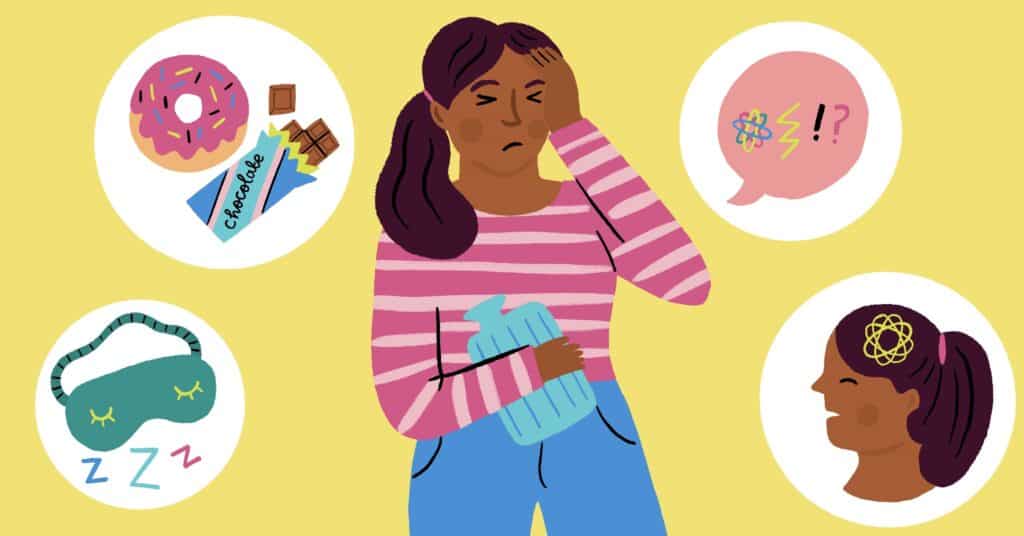
By Maria Romaszkan
If you’re female and have ADHD and you feel miserable when your period is about to start, you’re not alone. It seems that the menstrual cycle and ADHD affect each other in significant ways, though scientists are still figuring out why.
What is Premenstrual Dysphoric Disorder?
Premenstrual dysphoric disorder, or PMDD, is a mood disorder arising in the premenstrual phase of the menstruation cycle. Often described as a more severe form of premenstrual stress, or PMS, the symptoms can appear one or two weeks before your period starts.
“PMDD affects one in 20 menstruators and is often described as a Jekyll and Hyde condition — where for up to half of every month, the person experiencing PMDD doesn’t recognize who they are,” says Ally Mchugh, a psychotherapist from the United Kingdom and co-founder of The PMDD Collective, a team of mental health professionals focusing on treating PMDD. “It impacts relationships, careers and can destroy a person’s sense of identity and self-esteem. They spend half the month feeling disconnected, angry and lost, then often spend the other half feeling guilt and regret, having to put the pieces of their lives back together, then experiencing anxiety about the next cycle that will come around all too quickly.
Symptoms of Premenstrual Dysphoric Disorder
PMDD is a serious condition that can affect your daily functioning every month, causing severe psychological discomfort, such as:
- Mood swings
- Anxiety
- Irritability or anger
- Depressive episodes
- Brain fog — difficulty concentrating
- Hopelessness
- Feeling tense
- Feeling out of control and overwhelmed
- Suicidal thoughts
Physical symptoms can also be present. They include:
- Fatigue
- Gastrointestinal issues
- Nausea, vomiting
- Breast tenderness
- Stiff and aching body
- Feeling bloated
- Changes in appetite and sleep patterns.
Premenstrual Dysphoric Disorder and ADHD
A Jan 2021 study published in the Journal of Psychiatric Research shone a light on a connection between ADHD and premenstrual dysphoric disorder. The study looked at women with ADHD after their first childbirth. It found a higher rate of conditions like premenstrual dysphoria and postpartum depression among the study participants, compared to the general population. It also underlined that many women with ADHD may suffer worsened symptoms of premenstrual dysphoric disorder.
Though science is only starting to look more closely at the connection between these two conditions, people with ADHD have been eager to speak out about these difficulties for a long time.
All of this may relate in part to the known connections between ADHD symptoms and the menstrual cycle. ADHD is associated with dysfunction in the dopamine neurotransmitter system, which experts believe is affected by hormonal changes during the menstrual cycle. Research has shown that estrogen levels can affect dopamine levels in the brain, and fluctuations in estrogen and progesterone levels during the menstrual cycle may contribute to changes in ADHD symptoms.
Emerging research suggests that that fluctuation in estrogen during the menstruation cycle can be crucial in how ADHD and premenstrual dysphoric disorder are connected.
“There is an undeniable neurodivergence and PMDD cross-over, but it’s not yet clear why,” says Emily Holloway, a UK-based psychotherapist and the other co-founder of The PMDD Collective. “Estrogen plays an important role in the receptors that produce dopamine and serotonin — so it’s no surprise that when estrogen levels are lower, ADHD symptoms may be increased.”
How To Manage Premenstrual Dysphoric Disorder?
Here are some important steps that you can take to help manage PMDD:
• Know your cycle
You can use a mobile app or a calendar to track your cycle and notice when and which symptoms will most likely appear and how long they usually last. This will help you prepare in advance.
You can adjust your plans and avoid stressful events during this period.
Consider making a care box so you have everything you need at hand — food, medicine, favorite blankets, comfort books or movies.
“Living cyclically can be a game changer in managing the impact of PMDD — planning work, social plans and even exercise routine around the menstrual phase,” says Holloway. “Living with premenstrual dysphoria is at times excruciating; self-care and self-compassion are vital.”
• Mind your diet and sleep
A healthy and balanced diet may help you manage your premenstrual dysphoric disorder and ADHD symptoms.
You probably crave carbs in the form of sugary treats before your period. However, avoid processed foods and refined sugars, and reach for healthier alternatives, such as whole grains or protein. They will help you keep your energy levels and mood more consistent.
Remember also to drink plenty of water and limit coffee and alcohol. What’s more, try reducing the amount of salt in your diet to avoid excessive fluid retention.
Certain vitamins and minerals may help improve your condition, such as:
- Vitamin B6
- Calcium
- Magnesium
Consult your doctor to see if you should consider taking any supplements.
• Engage in regular physical activity
Regular physical activity can help improve your mood and manage ADHD symptoms, as it boosts dopamine production and releases endorphins.
Exercise may also be beneficial for premenstrual symptoms, both mental and physical.
You don’t have to start with high-intensity training or running marathons. Light or moderate exercise such as brisk walking, swimming or jogging is a great starting point.
• Find support
It may be embarrassing to talk about your period with friends or family. For trans or nonbinary people, it may also bring up painful emotions connected to their gender and body.
Remember that you don’t have to share anything you’re uncomfortable with, but try to open up about your feelings and needs.
You can also try reaching out to nonprofit organizations, such as the International Association For Premenstrual Disorders, which offers helpful resources and peer support.
• Learn strategies for managing stress
Stress can worsen your symptoms of both ADHD and PMDD, so it’s good to have strategies that help you cope with anxiety and overwhelm.
Try learning a few grounding techniques, such as breathwork or progressive muscle relaxation.
Meditation or yoga are also great ways to self-regulate or come down before bedtime.
If possible, spend time in nature, even if it’s a short walk in a local park.
• Consider medication
There are several types of medication commonly used to treat PMDD.
Antidepressants like selective serotonin reuptake inhibitors, or SSRIs, can effectively reduce symptoms and are usually the first choice in treating this condition.
It’s also possible to start taking birth control to stop ovulation and fluctuating hormones. This method can give you relief from PMDD symptoms.
If you’re struggling with swelling and bloating during this time, your doctor may prescribe diuretics, commonly known as water pills, to help you expel excess water from your body.
You may also take nonsteroidal anti-inflammatory drugs, such as ibuprofen, before your period starts to ease pain and cramping.
Be aware that estrogen levels may impact your ADHD medication’s effectiveness, worsening your symptoms. You might talk to your provider about a temporary stop in taking your ADHD medication during thus time, and using other non-medical therapies for help.
• Try therapy
“Therapy really helps take the sting out of the worst PMDD feelings and helps grow resilience and self-awareness,” Holloway says.
Cognitive behavioral therapy has shown especially promising results in helping manage the symptoms.
Certain studies suggest that mindfulness-based cognitive therapy can be helpful as well.






